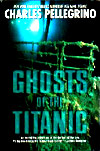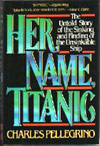|
| To Search This Site Enter Key Words Into Text Field On The Right and Hit The Search Button |
|
|
Charles Pellegrino. For more information, go to the author's website.
|

|
Pellegrino, Charles. Ghosts of the Titanic. 1st printing. NY: William Morrow. June, 2000. hardcover. isbn: 0688139558. scarcity: common.
Titanicdom’s most exuberant writer returns to the subject twelve years after his first phenomenally successful work on the subject. Pellegrino’s second foray into Titanic country also enjoyed massive mass market success, while simultaneously receiving mostly derision from the scholarly Titanic community.
And like his first book, this one is a perplexing maze of amazing insight on some pages, and absurd blunders on others. Honestly, the man can write an entertaining book, but he desperately needs to hire himself a competent research assistant to catch the many errors he allows to creep into his text.
Some mistakes are relatively minor, mixing up the stories of passengers Ada Clarke with Virginia Clark, for example. More serious are ‘facts’ that are outright wrong, like his assertion that popular Titanic author Walter Lord spoke with survivor Jack Thayer, quite a trick considering Thayer died almost 15 years before Lord started researching his book.
Then there are the outright fabrications, like the following exchange between two officers on the Californian, who were watching a ship in the distance which may or may not have been Titanic:
Stone shook his head and declared, “That other ship is definitely gone.”
“Gone to the bottom do you think?” the apprentice asked.
The second officer’s silence, and a second flurry of falling stars, seemed answer enough.
This is pure fiction. There is no documentation that these men ever said these words.
Some of his theories are equally farfetched; based on the flimsiest of evidence. A satchel of personal effects salvaged from the debree field cannot be identified as to its owner. Pellegrino twists this into proof that some of the crew were looting first class cabins. Never mind that most of the items found in the satchel had minimal value. Besides, if you were on a sinking ship, and knew your chances of getting into a lifeboat were just about nil, would you wander around below decks rifling cabins without ever knowing when the ship might founder leaving you trapped below?
Other theories are more plausible. Three of the more interesting ones are his downblast theory, his theory about the incredibly popping Grand Staircase, and his fascination with the complexities of the rusticles eating the wreck’s iron.
Many scholars doubt the downblast theory, and scoff completely at the popping Grand Staircase theory. Never the less, Pellegrino presents these arguments in an intelligent and thoughtful manner which deserve serious debate. The explanation of his downblast theory is particularly well thought out, and is a credible version of what might have happened to the stern section of the ship as it sank. And his research on the rusticles is nothing short of fascinating.
The problem for the casual reader is that they aren’t in a position to tell the fact from the fabrication in this book. As such, my warning about his first book applies equally well for this one; unless you know your Titanic history well, you cannot depend on this book for the facts.
|
|
Pellegrino, Charles. Ghosts of the Titanic. 1st paperback edition. NY: Avon Books. July, 2001. wraps. isbn: 0380724723. scarcity: common.
This new edition apparently has a few minor corrections and additions.
|
 |
Pellegrino, Charles. Her Name Titanic. 1st printing. NY: McGraw-Hill. 1988. hardcover. isbn: 0070492808. scarcity: common.
This book is billed as a companion piece to Dr. Ballard’s book The Discovery of the Titanic, but Pellegrino has written a much more eclectic work which meanders all over the landscape, drifting far away from any relation to Titanic story as often as not. A lot of the material is biographical in nature, and about the quest for exploration in general. There is, however, quite a lot of material concerning Ballard.
When the text does wander back to Titanic, some serious issues crop up. The author has an amazingly active imagination for a scientist. He enthusiastically relates entire conversations amongst members of the ship’s crew, and for the most part these passages are entirely fictitious. Pellegrino admits as much at the end of the book, saying (and I am paraphrasing him here) he wanted to capture the ‘feel’ of the moment, if not the literal truth.
Oddly enough, it is the liberties taken with the facts that help make Pellegrino’s book so entertaining to read. He is obviously enthusiastic about his subject, and it shows in his writing. If you approach this title as an interesting read, you won’t be disappointed, but readers who do not know their Titanic history well should be wary of depending on this text for the facts.
|
|
Pellegrino, Charles. Her Name Titanic. 1st British printing. Lon: Robert Hale. 1990. hardcover. isbn: . scarcity: hard to find.
|
|
|
|
|